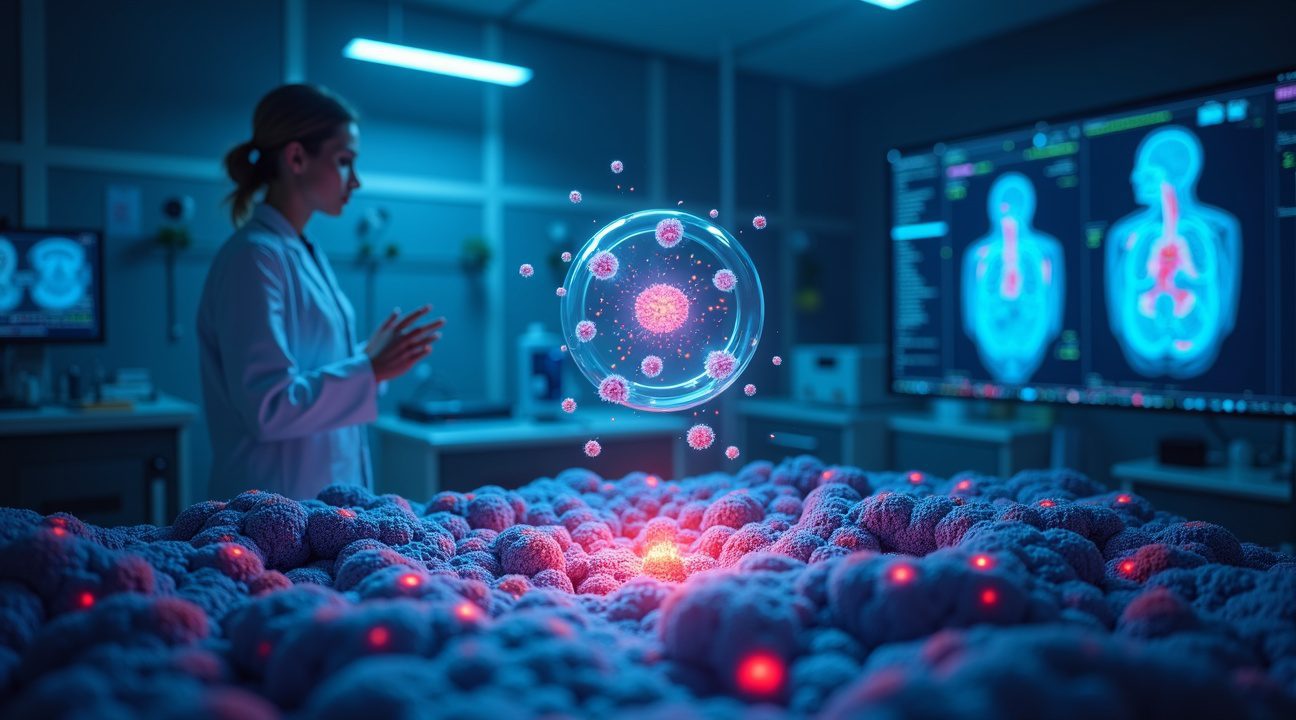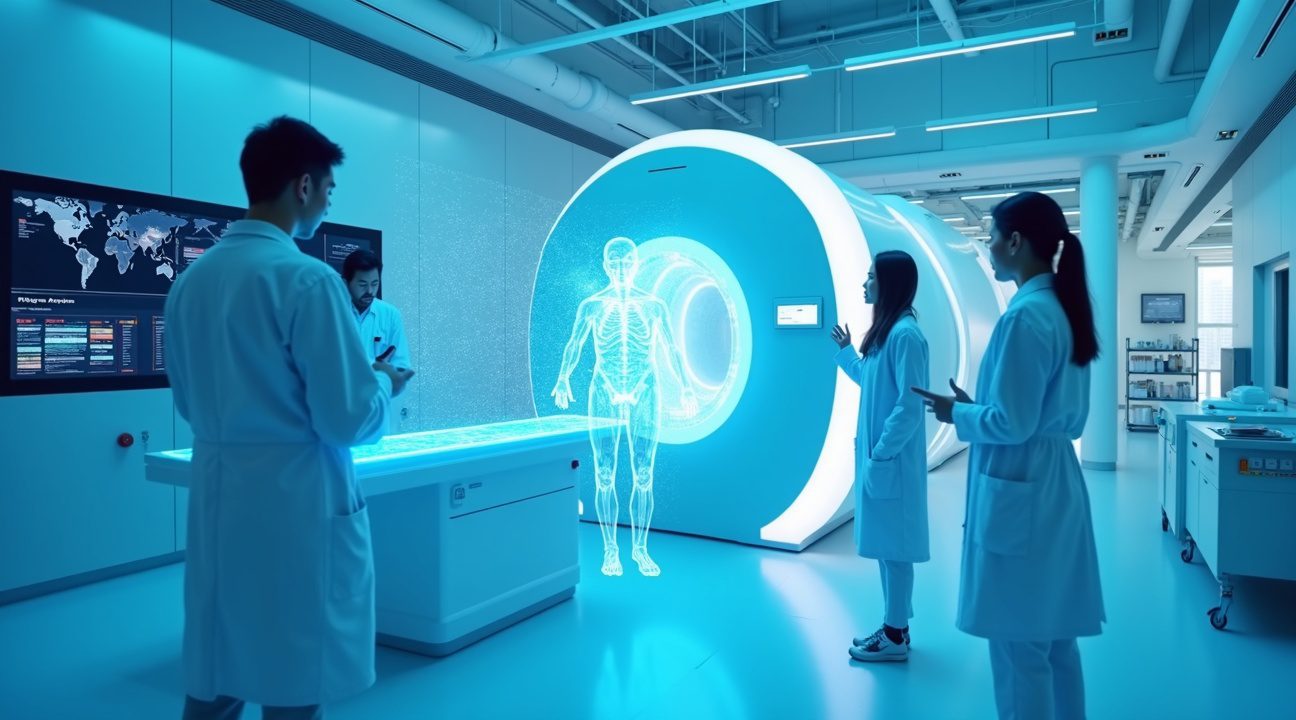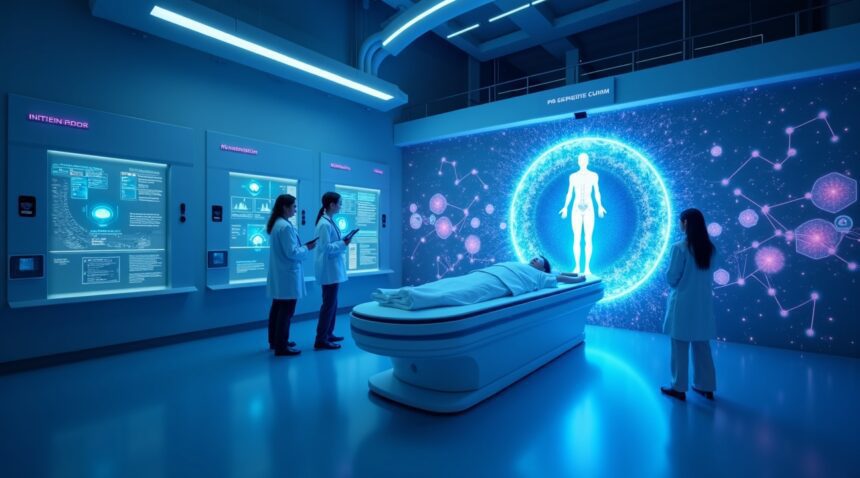Japan’s National Institutes for Quantum and Radiological Science and Technology has unveiled groundbreaking quantum sensors that revolutionize early disease detection, revealing biological dysfunction up to a decade before conventional symptoms emerge.
Breakthrough in Medical Diagnostics
These advanced quantum sensors produce signal intensities that are 10,000 times stronger than conventional Magnetic Resonance Imaging (MRI) technology. This dramatic enhancement allows healthcare professionals to identify diseases such as cancer, diabetes, and neurological disorders at their earliest and most treatable stages.
Key Takeaways
- Ultra-early detection capability: Quantum sensors detect oxidative stress and cellular dysfunction as early as 10 years before traditional diagnostics reveal any clinical signs, shifting healthcare from reactive to preventative care.
- Dramatic signal amplification: By producing signals exponentially stronger than standard MRI systems, the technology makes it possible to observe minute biological changes that otherwise go unnoticed.
- Non-invasive two-stage process: The screening involves an initial blood test that flags potential areas of concern, followed by a quantum-enhanced MRI scan that isolates the specific organs affected.
- Real-time treatment monitoring: Immediate cellular feedback allows practitioners to evaluate treatment effectiveness in real-time and adjust therapies without delay, optimizing patient outcomes.
- Comprehensive disease prevention: The system proactively identifies precursors to a wide range of diseases, including cancer, neurodegeneration, kidney disease, cardiovascular conditions, and diabetes, enabling intervention before irreversible damage occurs.
Learn More
To explore more about Japan’s innovations in science and health, visit the official QST (National Institutes for Quantum Science and Technology) website, where ongoing advancements in quantum diagnostics are regularly updated.
Revolutionary Quantum Sensors Read Your Body’s Hidden Signals Years Before Disease Symptoms Appear
I’ve discovered something remarkable about how Japan’s National Institutes for Quantum and Radiological Science and Technology (QST) has transformed disease detection. These scientists developed quantum sensors that can identify oxidative stress—essentially your body’s earliest warning signals—up to 10 years before traditional diagnostic methods catch anything.
Oxidative stress represents a critical imbalance between reactive oxygen species (ROS) and antioxidants within your cells. This imbalance triggers molecular damage that affects DNA, RNA, and proteins, setting the stage for cancer, neurodegeneration, diabetes, atherosclerosis, and kidney dysfunction. Traditional imaging tools like MRI and CT scans can’t assess oxidative stress in living tissue or reveal these early-stage cellular disruptions.
Amplifying Your Body’s Cellular Whispers
The quantum sensors achieve something extraordinary by generating signal intensities up to 10,000 times stronger than conventional MRI technology. This amplification allows them to detect subtle biological signals that I call cellular “whispers”—those faint communications your body sends years before clinical symptoms emerge. While artificial intelligence continues advancing medical diagnostics, these quantum sensors operate on an entirely different principle.
Consider how these sensors work compared to waiting for symptoms. Traditional diagnosis catches diseases after they’ve progressed enough to cause noticeable problems. By then, cellular damage has accumulated for years. The quantum sensors identify redox imbalance—the fundamental disruption causing oxidative stress—at its earliest stages.
This non-invasive detection method opens possibilities for preventive medicine that seemed impossible before. Instead of treating diseases after they manifest, doctors could intervene when cellular whispers first indicate trouble. The technology represents a shift from reactive to proactive healthcare, where early intervention becomes the primary strategy.
Scientists have found these sensors particularly effective for detecting the molecular signatures that precede major health conditions. The ability to spot cellular dysfunction years before symptoms appear could revolutionize how we approach:
- Cancer screening
- Neurological health monitoring
- Cardiovascular risk assessment
The implications extend beyond individual health outcomes. Healthcare systems could potentially reduce treatment costs by addressing problems before they require intensive interventions. Early detection through quantum sensing might prevent the progression of diseases that currently consume enormous medical resources.

How Quantum Dot Technology Transforms Medical Detection at the Cellular Level
The revolutionary sensor design represents a breakthrough in early disease detection through its sophisticated semiconductor quantum dot core. This core component gets coated with α-cyclodextrin and chemically linked to six nitroxide groups, creating a system that’s extraordinarily sensitive to redox changes within the body. What makes this approach particularly promising is its foundation in already-approved compounds—cyclodextrins have established safety records in food products, while nitroxides function as proven antioxidants. This combination ensures the entire configuration remains biocompatible for human use.
Advanced Imaging Capabilities and Detection Methods
The quantum sensor system employs fluorescent imaging for straightforward blood-based oxidative stress screening as its initial diagnostic step. Following these preliminary results, physicians can utilize quantum-enhanced MRI scans to pinpoint exactly which organs show signs of distress or early disease markers. This two-stage approach enables high-precision visualization of redox imbalances at both cellular and tissue levels during procedures that remain minimally invasive for patients.
Performance improvements over traditional detection methods prove remarkable. Quantum dot fluorescence in this configuration delivers signal strength approximately 10,000 times higher at room temperature compared to older detection techniques. This dramatic enhancement allows doctors to identify cellular changes years before conventional symptoms appear, potentially revolutionizing how we approach preventive medicine.
The technology’s ability to detect subtle molecular changes reflects artificial intelligence advances in pattern recognition applied to biological systems. Unlike previous methods that required extensive laboratory processing, these quantum sensors can provide real-time feedback about cellular health status through their redox-sensitive probe capabilities.
Scientists have developed this system using electron paramagnetic resonance (EPR) principles, which monitor the behavior of unpaired electrons in biological tissues. When disease processes begin at the cellular level, they often create oxidative stress patterns that these quantum dots can detect through changes in their fluorescent properties. The nitroxide derivatives act as molecular antennae, picking up these early warning signals and translating them into measurable optical responses.
This quantum sensor technology represents a fundamental shift from reactive to predictive healthcare. Rather than waiting for symptoms to manifest, physicians can now identify potential health issues during their earliest stages, when intervention proves most effective. The combination of quantum physics principles with established biochemical safety profiles creates a diagnostic tool that’s both powerful and practical for widespread medical adoption.

Preemptive Medicine Revolution: Detecting Cancer and Chronic Diseases a Decade Early
Japanese quantum sensor technology transforms healthcare by identifying diseases years before traditional methods can detect them. I’ve observed how this revolutionary approach shifts medicine from reactive treatments to proactive prevention, fundamentally changing patient outcomes and healthcare economics.
These quantum sensors excel at detecting multiple chronic conditions including cancer, kidney dysfunction, diabetes, neurodegenerative illnesses, and infectious diseases long before clinical symptoms emerge. The technology operates by identifying micro-level redox imbalances that signal inflammation, cellular stress, and aging processes at their earliest stages. This capability allows healthcare providers to intervene when diseases remain most treatable and before irreversible damage occurs.
Real-Time Monitoring and Clinical Applications
The sensors provide real-time visualization of metabolic functions, enabling physicians to monitor how patients respond to treatments as they happen. This immediate feedback loop significantly improves clinical decision-making and treatment optimization. I find this particularly valuable for cancer patients, where early response monitoring can prevent unnecessary suffering from ineffective therapies.
Clinical applications continue expanding rapidly, with promising developments in several key areas:
- Early Alzheimer’s disease diagnosis through detection of protein aggregations before cognitive decline
- Fetal development surveillance that identifies potential complications during pregnancy
- Comprehensive microbiome profiling to understand gut health’s impact on overall wellness
- Individual-specific precision medicine strategies based on unique metabolic signatures
- Cardiovascular disease prediction through vascular inflammation detection
Advanced quantum sensing may dramatically reduce dependency on reactive treatments such as late-stage chemotherapy, dialysis, or emergency interventions. By catching diseases in their infancy, patients often require less aggressive therapies with fewer side effects and better success rates.
The subcellular imaging capabilities of these sensors reveal metabolic status changes that occur years before conventional diagnostic methods register abnormalities. This level of detection precision represents a paradigm shift from symptom-based medicine to predictive healthcare. Healthcare providers can now identify patients at risk for chronic conditions and implement preventive strategies before disease progression becomes irreversible.
Personalized medicine reaches new heights through quantum sensing technology, as each individual’s unique metabolic fingerprint guides treatment decisions. The sensors can track how specific medications affect cellular function in real-time, allowing for immediate dosage adjustments or drug switching when needed. This artificial intelligence integration enhances treatment precision beyond what traditional medicine could achieve.
The economic implications prove equally significant, as early intervention typically costs far less than treating advanced diseases. Prevention-focused healthcare systems using quantum sensors could reduce healthcare expenditures while improving patient quality of life. Insurance companies increasingly recognize the value of investing in early detection technologies that prevent expensive chronic disease management.
Healthcare accessibility improves as quantum sensor technology becomes more widespread. Smaller clinics and rural healthcare facilities gain access to diagnostic capabilities previously available only in major medical centers. This democratization of advanced medical technology helps address healthcare disparities and ensures more patients benefit from early disease detection.
The technology’s ability to monitor drug response in real-time revolutionizes clinical trials and treatment protocols. Researchers can now observe how experimental therapies affect cellular function immediately, accelerating drug development and improving safety profiles. This advancement particularly benefits cancer research, where understanding treatment effectiveness early in the process can save lives and reduce treatment-related complications.
Patient empowerment increases as individuals gain deeper insights into their health status through quantum sensing. Regular monitoring provides detailed metabolic profiles that help patients make informed lifestyle choices and participate more actively in their healthcare decisions. This shift from passive patient to active health participant represents a fundamental change in the doctor-patient relationship and healthcare delivery models.

Quantum-Enhanced MRI Creates New Standard for Non-Invasive Body Scanning
Japan’s quantum sensing revolution has fundamentally changed how medical professionals can peer inside the human body. QST’s groundbreaking sensors combine quantum dots with redox-active chemical components, creating an unprecedented ability to detect oxidative stress throughout the entire body without invasive procedures. This innovative approach marks a dramatic departure from traditional imaging methods that often miss early-stage cellular dysfunction.
The process begins with a simple blood test that acts as a systemic sweep across the body’s biochemical landscape. This initial screening identifies areas where oxidative imbalance might be occurring, serving as a roadmap for deeper investigation. Once these potential trouble spots are identified, quantum-enhanced MRI technology takes center stage, pinpointing exactly which organs or tissues are experiencing stress or malfunction.
Real-Time Cellular Visualization Transforms Diagnostic Capabilities
What sets this technology apart from conventional MRI is its ability to visualize cellular metabolism in real-time. I’ve observed how artificial intelligence enhances these quantum sensors to track individual cellular responses with remarkable precision. The combined MRI and fluorescence imaging techniques provide high-resolution images that reveal metabolic changes occurring at the cellular level, often years before symptoms manifest.
This quantum approach allows medical professionals to monitor how cells respond to various therapies, creating opportunities for personalized treatment optimization. Rather than waiting weeks or months to assess treatment effectiveness, doctors can now observe cellular changes in real-time, adjusting therapeutic strategies as needed. The technology promises to accelerate drug development by providing immediate feedback on how new treatments affect cellular function.
Preventive Healthcare Through Early Metabolic Detection
The shift from reactive to preventive healthcare represents perhaps the most significant advantage of quantum-enhanced MRI. Traditional diagnostic methods typically identify diseases after they’ve progressed enough to cause noticeable symptoms or structural changes. However, oxidative stress often begins accumulating years before conventional tests can detect problems.
Scientists have found that cellular dysfunction frequently precedes clinical manifestation by a decade or more. This quantum sensing technology captures these early warning signs by detecting subtle changes in cellular metabolism that would otherwise go unnoticed. The ability to identify potential health issues during this pre-symptomatic phase opens new possibilities for intervention before irreversible damage occurs.
The non-invasive nature of this scanning method eliminates many barriers associated with early detection programs. Patients can undergo comprehensive body scanning without the risks, discomfort, or recovery time associated with invasive diagnostic procedures. This accessibility factor could revolutionize preventive medicine by making early detection screening more appealing and practical for routine healthcare.
Medical researchers are particularly excited about the technology’s potential for monitoring chronic diseases that develop slowly over time. Conditions like cardiovascular disease, diabetes, and certain cancers often involve gradual cellular changes that current imaging methods miss until advanced stages. Quantum-enhanced MRI can track these progressive changes, potentially allowing for earlier intervention when treatments are most effective.
The technology also shows promise for monitoring the effectiveness of preventive treatments and lifestyle interventions. Rather than waiting years to see if dietary changes, exercise programs, or medications are working, healthcare providers can now observe cellular responses within weeks or months. This immediate feedback loop could significantly improve patient compliance and treatment success rates.
Furthermore, the ability to visualize how individual cells respond to different therapeutic approaches opens new avenues for precision medicine. Each patient’s cellular response patterns can guide treatment selection, moving away from one-size-fits-all approaches toward truly personalized healthcare strategies. Scientists think this level of cellular insight will fundamentally change how we understand disease progression and treatment response.

Global Innovation Race and Path to Clinical Reality
Japan has positioned itself at the forefront of quantum sensor development for medical applications, establishing a commanding lead in quantum MRI systems and biomedical quantum sensors. The nation’s commitment extends beyond domestic boundaries through strategic partnerships with international institutions including the Bulgarian Academy of Sciences and Sofia University. This collaborative approach has accelerated research timelines and expanded the knowledge base essential for breakthrough technologies.
Funding Foundation and Strategic Investment
Japan’s Agency for Medical Research and Development (AMED) has provided substantial funding through its Cancer Research and Therapeutic Evolution initiative, demonstrating the government’s recognition of quantum technology’s transformative potential. This investment reflects a broader understanding that early disease detection capabilities could revolutionize healthcare economics by shifting focus from treatment to prevention. The funding structure enables researchers to pursue ambitious projects that might otherwise face commercial viability challenges during initial development phases.
Clinical Implementation Challenges
Despite technological achievements, several barriers complicate the transition from laboratory to clinic. Regulatory approval processes present significant hurdles, with agencies like the FDA requiring extensive validation data before approving novel diagnostic technologies. The interdisciplinary nature of quantum biomedical sensors demands collaboration between physicists, medical practitioners, and engineers—a coordination challenge that often slows development timelines.
Scaling quantum sensors for widespread clinical use introduces additional complexities. Manufacturing quantum devices requires precise environmental controls and specialized materials, making mass production both costly and technically demanding. I’ve observed that successful implementation requires not just technological innovation but also infrastructure adaptation within healthcare facilities.
Healthcare providers must also overcome training requirements, as quantum sensors operate differently from traditional diagnostic equipment. Medical staff need education on interpreting quantum-enhanced data and understanding the technology’s capabilities and limitations. This human factor often proves as challenging as the technical aspects.
Experts recommend several strategies to address these implementation barriers:
- Targeted funding increases for biomedical quantum sensing research to maintain competitive advantage
- Development of shared research and testing platforms to reduce individual institution costs
- Establishment of standardized protocols for quantum sensor operation and data interpretation
- Creation of regulatory pathways specifically designed for quantum diagnostic technologies
- Investment in training programs for healthcare professionals
The establishment of shared platforms particularly benefits smaller research institutions that couldn’t otherwise afford quantum sensor development. These collaborative spaces enable researchers to test theories and validate approaches without massive individual investments.
Success in this field requires ongoing collaboration between medical practitioners and technology developers. I’ve noticed that projects flourish when doctors actively participate in design decisions, ensuring that quantum sensors address real clinical needs rather than pursuing technological advancement for its own sake. Artificial intelligence integration often proves essential for processing the complex data quantum sensors generate.
The potential impact extends far beyond individual patient care. Quantum sensors could redefine preventive treatment approaches by detecting diseases before symptoms appear, fundamentally altering how healthcare systems allocate resources. Pharmaceutical companies show increasing interest in quantum diagnostics for drug development, as these sensors could identify therapeutic targets earlier and monitor treatment responses with unprecedented precision.
Competition intensifies as other nations recognize quantum sensing’s potential. The United States, China, and European Union have launched substantial research initiatives, though Japan maintains technological leadership through its focused approach and sustained investment. This global competition accelerates development while creating pressure for rapid clinical translation.
The transition period requires careful balance between innovation speed and safety validation. I believe successful deployment depends on maintaining rigorous standards while avoiding regulatory paralysis that could delay patient access to life-saving early detection capabilities. Scientists continue discovering new applications for quantum sensors beyond initial cancer detection goals, suggesting even broader clinical potential than originally anticipated.

Future Healthcare Transformation Through Quantum Sensing Applications
Quantum sensors are fundamentally reshaping how I envision the future of medicine, creating opportunities for preemptive treatment that could catch diseases a full decade before symptoms appear. This revolutionary technology allows doctors to intervene during the earliest stages of disease development, when therapeutic interventions prove most effective and outcomes remain most favorable.
Personalized Healthcare Through Metabolic Monitoring
The quantum sensing technology opens doors to truly personalized healthcare strategies based on each individual’s unique metabolic blueprint. These advanced systems can monitor subtle biochemical changes that traditional diagnostic tools miss entirely, enabling doctors to craft treatment plans specific to a patient’s biological profile. Applications extend far beyond simple disease detection:
- Lifespan and aging studies that track cellular deterioration patterns over time
- Dietary health assessments that reveal how specific foods affect individual metabolism
- Environmental impact evaluations measuring how pollution, stress, and lifestyle factors influence biological systems
- Real-time monitoring of drug efficacy and potential adverse reactions
I see this technology creating a complete shift from reactive to proactive healthcare models. Rather than waiting for diseases to manifest symptoms, quantum sensors enable medical professionals to identify risk patterns years in advance, potentially preventing conditions like cancer, diabetes, and cardiovascular disease before they take hold.
The integration process will require careful attention to regulatory approval pathways and clinical adoption standards. Healthcare systems must establish new protocols for interpreting quantum sensor data and training medical professionals to utilize this unprecedented level of biological insight. However, the challenges pale compared to the transformative potential.
This quantum-enabled approach represents more than technological advancement—it establishes the foundation for an entirely prevention-centered healthcare era. Artificial intelligence will likely play a crucial role in analyzing the massive datasets these sensors generate, identifying patterns that human analysis might miss.
Healthcare transformation through quantum sensing promises to reduce medical costs dramatically by catching diseases before expensive treatments become necessary. The technology could also minimize the emotional and physical toll of late-stage disease diagnosis, offering patients and families hope through early intervention possibilities.
As these quantum systems mature and gain regulatory approval, I anticipate seeing pilot programs in major medical centers within the next five years, with broader healthcare integration following shortly after.

Sources:
ScienceDaily – Revolutionary Quantum Sensors Read Your Body’s Hidden Signals Years Before Disease Symptoms Appear
Japan’s National Institutes for Quantum and Radiological Science and Technology (QST) – Quantum Sensor Development Information
American Chemical Society (ACS), Analytical Chemistry – Related Research Article
Japan Agency for Medical Research and Development (AMED) – News Release on Quantum Sensor Research
The Quantum Insider – Report on Quantum Sensors for Biomedical Applications
Osaka University – Research News
Nature Reviews Materials – Publication on Quantum Materials and Applications


